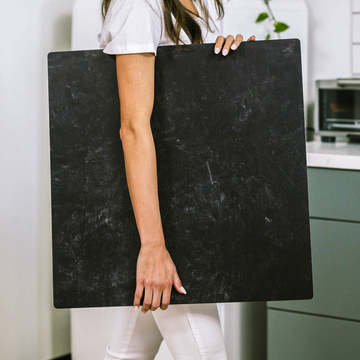Ever wondered why your food photos don't quite match the professionals? The answer might be sitting right under your culinary creation.
As someone who has spent over 15 years capturing everything from melting ice cream to steaming pasta, I've discovered that the humble photography board is far more than just a pretty backdrop. While most photographers obsess over camera settings and lighting, I've found that understanding the physics of your photography surface can be the game-changer that elevates your images from good to exceptional.
The Secret Life of Photography Boards
When we browse Instagram or flip through cookbooks, we naturally notice the rustic charm of wooden boards or the elegant sophistication of marble surfaces. But beneath these aesthetic choices lies a world of material science that directly impacts how your food appears in the final image.
Let me show you what most tutorials don't tell you.
Temperature Matters: How Different Boards Affect Your Food's Lifespan
Have you ever struggled to photograph ice cream before it turned into a puddle? The material under your food plays a crucial role:
Marble: The Cold Keeper
With its high thermal conductivity (2-3 W/m·K), marble quickly whisks heat away from hot foods and maintains coldness for chilled items. Pre-chill a marble board and you can extend your ice cream shooting time by up to 15 minutes compared to other surfaces!
Pro Tip: For my summer gelato shoot last year, I refrigerated my marble board overnight and was able to capture 25 different angles before any significant melting occurred.
Wood: The Warm Preserver
Wood's insulating properties (conductivity of just 0.1-0.2 W/m·K) keep warm foods looking fresh longer. This makes wooden boards ideal for capturing steaming soups or fresh-from-the-oven pastries when you need that appetizing heat haze.
Composite Boards: The Best of Both Worlds
Modern photography boards can be engineered with specific thermal properties for different food types. This is why I typically carry at least three different board materials to every commercial food shoot.
The Microscopic Magic: Surface Texture and Light
Let's zoom in-way in-to understand why some boards make food pop while others fall flat.
The surface roughness of your board (measured as an Ra value by material scientists) determines how light interacts with your setup. This isn't just theory; it transforms your images in practical ways:
- Smooth surfaces (low Ra values) create sharp reflections and clean highlights-perfect for minimalist, high-contrast food photography
- Textured surfaces (higher Ra values) diffuse light more evenly, creating a softer look with fewer harsh shadows
When photographing a dark chocolate ganache cake last month, I switched from a glossy surface to one with an Ra value of approximately 1.0μm. The difference was striking-the texture of the ganache became much more apparent, and the cake suddenly looked more appetizing without changing a single camera setting.
The Edge Effect: How Liquids Interact With Your Board
Have you noticed how professional food photos often have that perfect "juicy" quality? The secret often lies in understanding capillary action and contact angles.
When photographing foods with sauces, oils, or natural juices, the way these liquids interact with your board's surface creates either:
- Crisp, defined edges (on non-porous surfaces like sealed stone or glass)
- Soft, gradient borders (on semi-porous surfaces like unsealed wood)
This is why a splash of olive oil on a properly sealed wooden board forms that perfect, appetizing droplet with a contact angle between 70-80 degrees, while on the wrong surface it might look flat and unappetizing.
Choosing the Right Board: A Technical Approach Made Simple
Rather than selecting boards based solely on color or style, consider these practical factors for your next food shoot:
- What's the temperature of your food? Hot dishes? Choose wood. Cold items? Opt for marble or stone.
- How's your lighting setup? For hard, directional lighting, choose boards with more texture (Ra value 0.8-1.2μm) to soften harsh shadows. For soft, diffused setups, smoother surfaces enhance the delicate light.
- Does your dish have sauces or juices? For defined, appetizing liquid edges, select non-porous surfaces with proper sealing.
- How reflective should your surface be? For most balanced food photography, aim for surfaces with 18-22% reflectance-enough to add dimension without distracting from the food.
Beyond DIY: The Rise of Engineered Photography Surfaces
While traditional materials like marble and wood will always have their place, many professional food photographers (myself included) now use custom-engineered surfaces designed specifically for photography.
Companies like Replica Surfaces have revolutionized food photography by creating boards with precisely controlled properties:
- Optimized thermal characteristics
- Calibrated light diffusion
- Engineered edge interaction for liquids
- Consistent reflectance values
These surfaces remove much of the guesswork from selecting the perfect backdrop for your culinary creations.
Putting Knowledge Into Practice
Understanding these principles has transformed my approach to food photography. Recently, when shooting a campaign for an ice cream brand, I selected a composite board with high thermal conductivity but the visual appearance of rustic wood-giving me the best of both worlds.
The client was amazed that we captured 45 different setups without product meltdown issues, never realizing that the science behind my board selection was the unsung hero of the shoot.
Your Turn: Elevate Your Food Photography
Next time you're setting up a food shot, remember that your photography board isn't just a background-it's an active participant in creating your image. Consider the physics at play:
- How will the board's material affect your food's temperature and appearance over time?
- How will its surface texture interact with your lighting setup?
- How will liquids behave when they meet the surface?
By thinking beyond aesthetics and understanding these material interactions, you'll gain precise control over elements that most photographers leave to chance.
After all, in food photography, science and art aren't separate disciplines-they're partners in creating images that make viewers hungry at first glance.
What unexpected technical aspects have you discovered in your food photography journey? Share your experiences in the comments below!



